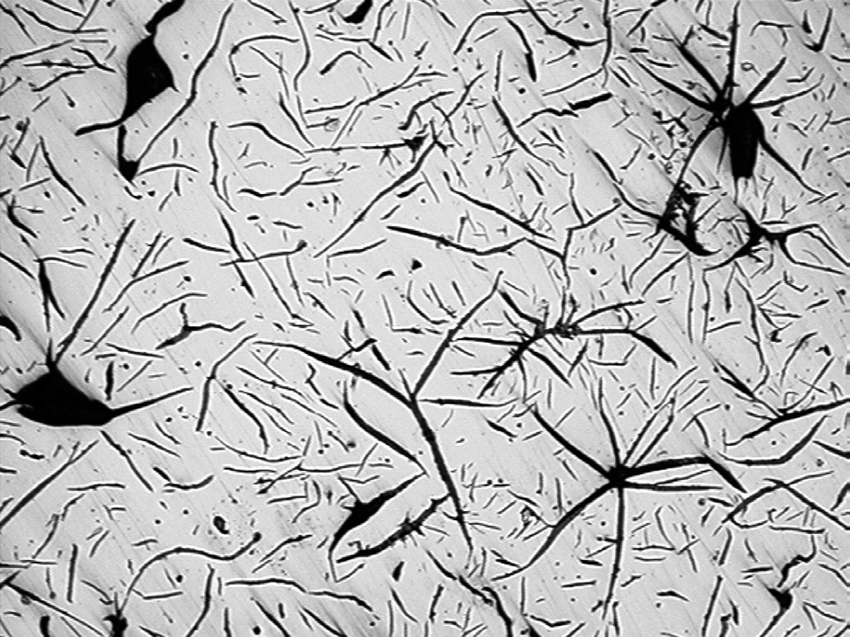Ductile Iron
ASTM A536-84
Also referred to as spheroidal or nodular iron, ductile iron is a cast iron that exhibits high strength, flexibility, durability, and elasticity due to it’s unique microstructure. Unlike the flake-like carbon microstructure of grey iron, the carbon in ductile iron is spheroidal, giving it the ability to be bent, twisted, or deformed by a specified percentage before fracturing. It’s mechanical properties far exceed those of standard grey cast iron, and are similar to steel at a fraction of steel’s cost.
Ductile Iron makes up over 80% of Leth Iron’s production.
| Grade | Min. Tensile (psi) | Min. Yield (psi) | Elongation (%) | Typical HBW |
|---|---|---|---|---|
| 60-40-18** | 60,000 | 40,000 | 18 | 140 – 190 |
| 65-45-12 | 65,000 | 45,000 | 12 | 160 – 220 |
| 70-50-09 | 70,000 | 50,000 | 9 | 170 – 230 |
| 80-55-06 | 80,000 | 55,000 | 6 | 190 – 260 |
| 100-70-03 | 100,000 | 70,000 | 3 | 240 – 310 |
**This is a grade that is achieved by heat treatment
Grey Iron

ASTM A48-03
Grey cast iron is often referred to simply as “cast iron”, because until ductile iron was developed it made up the vast majority of global iron casting volume. The microstructure of grey iron features flake-like graphite which under load can act as shear points, making it a poor choice for iron castings that need to withstand any sort of mechanical torsion. Grey cast iron is the iron of choice in applications focussed on simply shape, size, and weight with limited expectations of mechanical properties.
| Grade | Min. Tensile (psi) | Typical Hardness (HBW) |
|---|---|---|
| 20 | 20,000 | 120 – 180 |
| 25 | 25,000 | 150 – 210 |
| 30 | 30,000 | 180 – 240 |
| 35 | 35,000 | 180 – 240 |
| 40 | 40,000 | 210 – 270 |
High Chrome White Iron
ASTM A532-93A Class III Type A
The gold standard in abrasion resistance: ASTM A532 Class III Type A uses 27% ferrochrome to gain a hardness and wearability unlike any other alloy. This iron is universally trusted by farmers for use in ground-engaging elements and by media blasting companies for wear plates inside of blast cabinets. With hardness that can be conducive to fracture under mechanical impact or elongation, this alloy more than makes up for it’s brittle nature with superior wear in abrasive applications.
High Chrome White Iron makes up ~10% of Leth Iron’s production.
| Class/Type | % Chrome | Typical Hardness (HBW) |
|---|---|---|
| Class lll Type A | 27% Chrome | 550 – 700 |
Austempered Ductile Iron [ADI]
ASTM A897 – 06
Austempering is an isothermal heat treatment that involves heating ductile iron castings to between 1550°F and 1750°F in a controlled atmosphere followed by a quench in a bath of molten salt. The result is an incredible increase in casting strength and hardness while still maintaining a percentage of the elongation properties that ductile iron is famous for.
Leth Iron casts these parts, then sends them to our industry-leading partner Aalberts Surface Technology for heat treatment.
More on Aalberts at: aalberts-ht.us
| Trade Name | Grade | Min. Yield (psi) | Min Tensile (psi) | Elongation (%) | Typical Hardness (HBW) |
|---|---|---|---|---|---|
| Grade 1 | 130-90-09 | 90,000 | 130,000 | 9 | 269 – 341 |
| Grade 2 | 150-110-07 | 110,000 | 150,000 | 7 | 302 – 375 |
| Grade 3 | 175-125-04 | 125,000 | 175,000 | 4 | 341 – 444 |
| Grade 4 | 200-155-02 | 155,000 | 200,000 | 2 | 388 – 477 |
| Grade 5 | 230-185-01 | 185,000 | 230,000 | 1 | 402 – 512 |
Carbidic Austempered Ductile Iron [CADI]
CADI is a unique ductile iron made with both spheroidal graphite and carbides in the matrix. Once Austempered, CADI develops hardness and abrasion resistance properties that exceed those of ADI. In applications of high wear and high impact, CADI offers high abrasion resistance characteristics without the brittle nature of high chrome white iron.
Leth Iron casts these parts, then sends them to our industry-leading partner Aalberts Surface Technology for heat treatment.
More on Aalberts at: aalberts-ht.us
| Class/Type | Typical Hardness (HBW) | Carbide Percentage |
|---|---|---|
| CADI | 500 – 600 | 10-30% |
